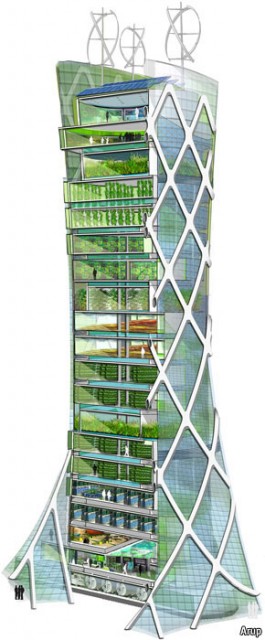 In both the developed and developing world, Vertical Farming is one method for energy conservation and sustained food security. According to Dickson Despommier, a Columbia professor of public and environmental health and author of The Vertical Farm, the global population is moving rapidly into dense urban areas, and as the remaining farmland becomes increasingly degraded, new solutions are needed for feeding the population efficiently. How do vertical farms stack up to the challenge?
In both the developed and developing world, Vertical Farming is one method for energy conservation and sustained food security. According to Dickson Despommier, a Columbia professor of public and environmental health and author of The Vertical Farm, the global population is moving rapidly into dense urban areas, and as the remaining farmland becomes increasingly degraded, new solutions are needed for feeding the population efficiently. How do vertical farms stack up to the challenge?
One advantage of vertical farming, in addition to year-round food production, includes water- and energy-saving measures such as converting black and gray water into potable water. This is accomplished by collecting the water of evapotranspiration and energy back to the grid via methane generation from composting non-edible parts of plants and animals. Vertical farms are already in place around the world from Singapore Sky Greens (featured in the travel section of the NYT) and locally in New York.
For example, Gotham Greens, a commercially successful, high-tech, 2,000 sq ft. greenhouse in Brooklyn announced in April their plans for another facility on top of the new Whole Foods supermarket in Gowanus. The new rooftop farm will include advanced irrigation systems which use 20 times less water than conventional farming. Though currently only at a small scale, their potential for growth is tremendous. Some innovative designs include the ARUP one design, featured in The Economist in 2010.
The vertical farm and its proponents are not without their critics. Sunlight doesn’t reach plants in the center of floors, and southern exposures get the most. Work-arounds, like adding artificial light to the interiors, are not energy efficient. As quoted in the Economist, Ted Caplow of New York’s Science Barge thinks that there are better ways to bring farms to cities, beyond the rooftops already in use. Barges, including his, already demonstrate an efficient method. With vertical farms the risk is sacrificing plausibility for sensationalism, but at the same time, more experimentation might yet hit on the perfect balance; the spill-over effect of an interest in urban farming has already led builders to include garden plots in the Via Verde development in the Bronx.
For more on vertical farming, watch below:
Image: ARUP